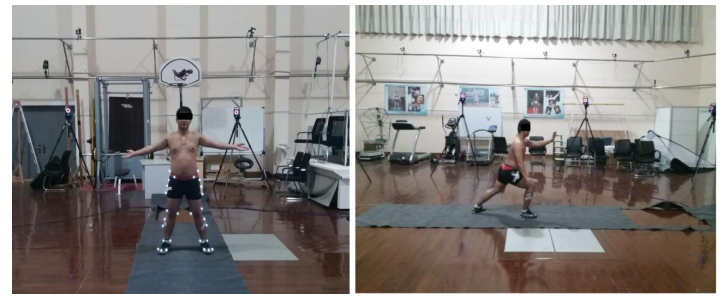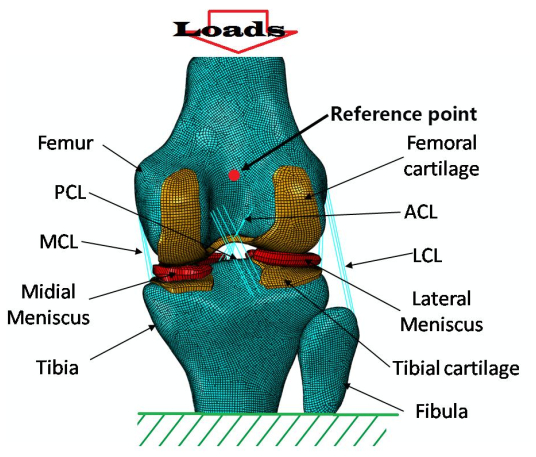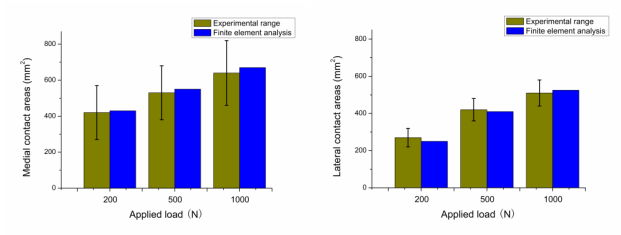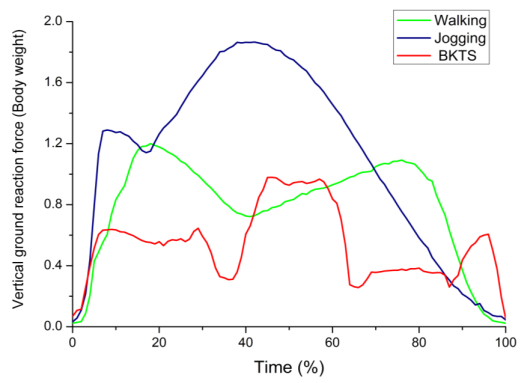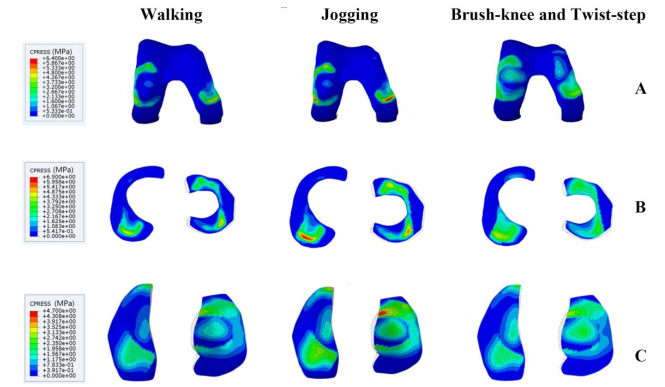This study aimed to analyze the biomechanical response of the knee cartilage and meniscus to a typical Tai Chi (TC) movement, brush-knee and twist-step (BKTS). Kinematic and kinetic data was recorded while an experienced TC practitioner performed normal walking, jogging and BKTS. The kinetic data were then imported into a validated finite element model of the knee joint to examine the biomechanical response of the articular cartilage and meniscus. Compared with walking and jogging, the BKTS movement showed a greater increase in the range of motion (ROM) of the knee. The ROM in the sagittal plane was 56° (walking), 38° (jogging) and 93° (BKTS). In coronal plane, the knee ROM was 8° (walking), 11° (jogging) and 28° (BKTS). And in horizontal plane the ROM was 17° (walking), 15° (jogging) and 29° (BKTS). The finite element simulation demonstrated that the pressure contact stress is much more concentrated during walking and jogging than BKTS, which is consistent with the lower peak contact stresses recorded on the cartilage and meniscus. In conclusion, the TC movement produced a gentler stress state on the meniscus and cartilage, while also requiring a greater knee ROM. Practicing TC may have a lower risk of knee joint injury compared to walking and jogging.
1.
Introduction
First, I take this opportunity to express my great admiration toward Professor Goong Chen by dedicating this paper to him on the occasion of his 70th birthday.
In this paper, we mainly consider the problem of vibrations governed by 1D wave equation wtt−c2wxx=0, where c denotes wave propagation speed, associated with a generalized boundary condition. Recall the definition of chaos for this kind of system, which is firstly introduced in [1], as below:
Definition 1.1. Consider an initial-boundary problem (S) governed by 1D wave equation wtt−c2wxx=0 defined on a segment I, where c>0 denotes the propagation speed of the wave. The system is said to be chaotic if there exists a large class of initial data (w0,w1) such that
(i) |wx|+|wt| is uniformly bounded,
(ii) V(t)def=VI(wx(⋅,t))+VI(wt(⋅,t))<+∞ for all t≥0,
(iii) lim inft→+∞lnV(t)t>0.
Remark 1.1. When chaos occurs, the function x↦(|wx|+|wt|)(x,t) is uniformly bounded, whereas the length of the curve {(x,(|wx|+|wt|)(x,t)),x∈[0,1]} grows exponentially w.r.t. time t. Therefore, the system (S) must undergo extremely complex oscillations as time t increasing.
Remark 1.2. There are lots of work about chaos studies, see e.g., [2,3,4] and references therein. As we know, there is no a common mathematical definition for chaos, which is actually a challenge to give. However, Li-Yorke chaos is probably one of the most popular and acceptable notions of chaos. We will study the relationship between Li-Yorke chaos and chaos in the sense of Definition 1.1 in our future work. Particularly, if chaos happens and the solution (wx,wt) can be represented by two interval maps, denoted by K1 and K2, respectively, then K1 and K2 have positive entropy, which implies K1 and K2 are chaotic in the sense of Li-Yorke.
Let us take a classical model to introduce the research background and our motivation, as below:
where α,β, and η are given constants. If η=1, the system (1.1) is not well-posed. Thus throughout this paper we assume η≠1. The wave equation itself is linear and represents the infinite-dimensional harmonic oscillator. Let
be the energy function of this system. And assume that (1.1) admits a C2 solution, then the boundary conditions show
The right-handed side boundary condition (at x=1) is nonlinear when β≠0, which is usually called a van der Pol type boundary condition (see, e.g., [1,5,6,7,8,9]). The left-handed side boundary condition (at x=0) is linear, where η>0 indicates that energy is being injected into the system at x=0. Thus if η>0, the system (1.1) has a self-excited mechanism that supplies energy to the system itself, which induces irregular vibrations [1,6]. In particular, when η=0, the free end at x=0 has no effect to the energy, which is also called an energy-conserving boundary condition.
The existence and uniqueness of the classical solution of (1.1) can be found in [5,6]. Furthermore, the system (1.1) has a smooth solution w∈C2 if the initial data satisfy
where
see Theorem 6.1 in [6]. The weak solution as well as its numerical approximation are discussed in [9].
The PDE system (1.1) has received considerable attention since it exhibits many interesting and complicated dynamical phenomena, such as limit cycles and chaotic behavior of (wt,wx) when the parameters α,β and η assume certain values [1,6]. Different from dynamics of a system of ODEs, this is a simple and useful infinite-dimensional model for the study of spatiotemporal behaviors as time evolutes. For instance, the propagation of acoustic waves in a pipe satisfies the linear wave equation: wtt−wxx=0. As we know, the solution of 1D wave equation describes a superposition of two traveling wave with arbitrary profiles, one propagating with unit speed to the left, the other with unit speed to the right. The boundary conditions appeared in (1.1) can create irregularly acoustical vibrations ([1,6,7]). This type of vibrations, for example, can be generated by noise signals radiated from underwater vehicles, and there are intensive research for the properties of acoustical vibrations in current literature (see e.g., [10] and references therein). Hence the study of this type of vibration is not only important but also may lead to a better understanding of the dynamics of acoustic systems.
In this paper, we mainly consider the oscillation problems described by the following models:
where the function h∈C0(R) satisfies
(A1) ϕ:t↦12(h(t)−1ct) strictly monotonically decreases on R,
(A2) ϕ(R)=R.
It is clear that ϕ−1:R→R is well-defined and strictly decreases on R. In fact, the model (1.4) is a generalized case of the van del Pol type boundary condition, h(x)=αx−βx3, say. Denote the total energy of system (1.4) as
then the boundary conditions show
Hence η>0 can cause the energy of system to increase. Moreover, the system (1.1) has a generalized self-excited mechanism if we assume that, roughly speaking, h(y)y>0 if |y| is small and h(y)y<0 if |y| is large. Thus if η>0, the system (1.4) has a self-excited mechanism that supplies energy to the system itself, which could induce irregular oscillations. The interesting part is that the system (1.5) may have chaos even though there is no energy supplier at the boundary.
We can treat the initial-boundary problems (1.4) and (1.5) by using wave propagation method. Let's take (1.4) as a start. It is well-known that w, a solution of 1D wave equation, has the following form:
where L and R are two C1 functions. Then the gradient of w can be represented as follows:
for x∈[0,1],t≥0. Introduce two new variables
which are called the Riemann invariants. It is evident that u and v keeps constants along the lines x+ct=const. and x−ct=const., respectively, which are referred to as characteristics.
When t>0 and x=0, from the boundary condition at the left end x=0,
that is
Without confusion, we also take γ(η) as a linear map.
When t>0 and x=1, from the boundary condition at the right end x=1, it follows:
that is
which determines a reflection relationship between u(1,t) and v(1,t) as follow
where
When t=0, from the initial conditions,
which are referred to as the initial date of (u,v).
For x∈[0,1] and τ≥0, it follows from the boundary reflections (1.9) and (1.10) that
and
inductively,
where the superscript n∈N denotes the nth iteration of a function. Analogously, for x∈[0,1] and τ∈[0,2c),
and
Equations (1.13)–(1.15) show that the system (1.4) is solvable and the dynamics of the solution (w,wx,wt) to the equation (1.4) can be uniquely determined by the initial data and the following two functions:
Note that g=γ−1(η)∘ψη∘γ(η), that is to say there is topological conjugacy between ψη and g. Therefore one only needs to consider one of them, say ψη.
The paper will be organized as follows. In the next two sections, we will present the necessary and sufficient conditions to cause the onset of chaos, respectively. Section 4 shows, as a special case, in which the wave equation has a fixed end, that chaos can occur with the effects of self-regulations and energy-conservation. In Section 5, there are some applications of the theoretical outcomes. In the last section, it is the numerical simulations.
2.
Necessary conditions for the onset of chaos
In this section, we firstly give a necessary condition for the onset of chaos in the following system:
where h satisfies hypotheses (A1) and (A2). In addition, assume the function t↦(h(t)+1ct) is piecewise monotone.
Theorem 2.1. Suppose the system (2.1) is chaotic in the sense of Definition 1.1. Then h is not even and η≠0.
Proof. It is equivalent to prove that there is no chaos in the system (2.1) if η=0 or h is an even function.
Firstly, assume h is an even function. Let η∈R and η≠c−1. Recall the function ψη given by (1.16):
Introduce a new map Q from R to R as follow:
For x∈R, let y=ϕ−1(x), then
Since ϕ−1 is strictly decreasing and γ(η)∈R∗, ψ is monotonic if and only if Q is monotonic. Let y1,y2∈R with y1<y2. From the hypothesis h being an even function, it follows
which implies Q strictly monotonically increases. Therefore ψ strictly monotonically increases (decreases) if γ(η)<0(γ(η)>0). It is easily seen that
Hence the dynamics of (wx,wt) is simple, and the chaos doesn't occur in the system.
Next, assume η=0, in other words, the system is free at the left end. In this case,
We will show that there is no period point of ψ0 with period 2. Let x0∈R satisfy x0<ψ0(x0). Define two functions as follows:
Since ϕ−1(⋅) strictly monotonically decreases and
k strictly monotonically increases in [x0,ψ0(x0)]. Hence
That implies there are no period points of ψ0 with period 2. By Sharkovsky's Theorem, there are no periods of ψ0 with period lager than 2. By virtue of the Main Theorem 6 in [12], there is still no chaos in the system when η=0.
Next, we consider the following system governed by 1D wave equation with a fixed end:
where h satisfies hypotheses (A1) and (A2).
Theorem 2.2. Suppose the system (2.3) is chaotic in the sense of Definition 1.1. Thenh is neither an even function nor an odd function.
Proof. Put
By the analysis in Section 1, it is clear that (zx,zt) can be represented by iterations of ψ∞ and initial data. Hence, the dynamics of (zx,zt) is completely determined by ψ∞.
If h is even, ψ∞ is monotonically monotone. If h is odd, −ψ∞ has no periodic points of period larger than 2. Therefore, chaos never occurs in the system 2.3 if h is either an even function or an odd function.
Remark 2.1. Chaos can definitely happen in the system 2.3 for a special kind of h. One can find more details about that in the later section.
3.
Chaotic oscillations of 1D wave equation with a general boundary feedback control law
In this section, we mainly try to determine some sufficient conditions to ensure the onset of chaotic oscillations in the following system:
where h∈C0(R) satisfies h(0)=0, hypotheses (A1) and (A2). When wt(1,t)≡0, there should be no signals feedback to wx(1,t), that's to say the right end should be free. Therefore it is reasonable to let h(0)=0.
According to the analysis in the first section, we have known that the function ψη given by (1.16) plays a vital role in studying the dynamics of system (3.1). We firstly give two lemmas that are useful in analyzing dynamics of ψη, as follow:
Lemma 3.1. Let I be a non-degenerate closed interval, J⊆R and F:I→J, G:J→R. Assume that VJG<+∞ and F is piecewise monotone. Then
Proof. Let I1=[a,b] be a monotone interval of F. Without loss of generality, let F monotonically increase in I1. Let
be a partition of I1. Then
where
is a partition of F(I1). Consequently, VI1G∘F≤VF(I1)G. Conversely, if
is a partition of of F(I1), then
where ˜F−1(q)=min{x∈I1,F(x)=q}, is a partition of I1. That implies
Therefore, VI1G∘F=VF(I1)G.
Let (Ij)1≤j≤n be a finite sequence consisting of monotone intervals of F. Assume ⊔1≤j≤nIj=I and #(Ii∩Ij)≤1 provided i≠j. Then,
Lemma 3.2. Let I be a closed interval and F∈C0(I,I) be piecewise monotone. If there exist non-degenerate subintervals I1,I2⊆A with Card(I1∩I2)≤1 such that I2⊆F(I1) and I1∪I2⊆F(I2), then
Proof. Let two subintervals I1,I2⊆A satisfy the hypothesis. Let n∈N. Put
where F0=IdR if n=0. Note that F(⋅) is continuous and piecewise monotone, it follows from Lemma 3.1 that
and
Let (zn)n∈N be Fibonacci sequence, i.e., zn+2=zn+1+zn, with the initial data z0=0,z1=1. It is well known that
It is clear that y1>0 and ∀n∈N,yn≥y1zn. Therefore,
This competes the proof.
Proposition 3.1. Let h∈C0(R) satisfy the hypothesises (A1)−(A2) and ψη be given by (1.16). In addition, assume h(0)=0 and
(i) non-constant function Q:t↦12(h(t)+1ct) is piecewise monotone,
(ii) there is at least one solution to the equation h(y)+c−1y=0 in R∗.
Then there exist A>0 and a non-degenerate interval I⊆(0,+∞)∖{c−1} such that for any η∈I, [0,A] is an invariant set of ψη and
Proof. We need to finish the following two steps:
(1) Determine an invariant interval [0,A] of ψη.
(2) To make sure the hypothesises of Lemma 3.2 holds.
It has been known that
Put
and
By the hypothesises (i)−(ii), S−≠∅ or S+≠∅. Without loss of generality, assume S−≠∅. We take
then
Moreover, let
By the definition of S−, it is evident that M=0 or m=0.
Case 1: Assume M=0. That implies m<0. Put
For any η∈[0,c−1), it is easily seen that
and ψη(x)<ψη(x0) provided that x∈[0,x0). We need to prove that m⋅γ(0)<A. Proceed the proof by contradiction. Assume m⋅γ(0)≥A, which implies
Thus ψ0 is turbulent. According to Lemma 3 in [11], ψ0 has periodic points of all periods. But from the proof of Theorem 2.1, ψ0 has no periodic points whose period is larger than 2. We have thus reached a contradiction. Since that m⋅γ(⋅) is strictly increasing in [0,c−1) and m⋅γ(η)→+∞ as η→(c−1)−, it is reasonable to put
Then for η∈[0,ˉη], we have
that is to say [0,A] is an invariant set of ψη provided η∈[0,ˉη]. Put
then η_<ˉη and ψ(x0)>x0 if η>η_. For η∈[η_,c−1), consider the following set:
It is clear that S(η,x0) is closed. Since x0 is uniquely determined by h and h is independent of η, the following function is well-defined:
We first prove that α(⋅) is strictly monotonically decreasing in [η_,c−1). Let t1,t2∈(η_,c−1) with t1<t2. From the definition of α(⋅), it follows
Since that
by applying the continuity of γ(t1)⋅φ(⋅) there exists x∈(α(t2),x0) such that γ(t1)⋅φ(x)=x0. According to the definition of α(t1), we have
Therefore, α(⋅) strictly monotonically decreases in [η_,c−1).
Next, prove that α(⋅) is continuous from the left. Let t0∈(η_,x0) be fixed. Since α is monotone, we have
By the continuity of η↦γ(η) and x↦φ(x), we obtain
which gives γ(t0)⋅φ(L)=γ(t0)⋅φ(α(t0))=x0. From the definition of α(⋅) and (3.10), it follows
Therefore α(⋅) is continuous from the left.
In particular, ψˉη(α(η_))=γ(η_)⋅φ(α(ˉη))=x0 and ψˉη(x0)=γ(η_)⋅φ(x0)=A. Define a function as follow:
It is easily seen that K(⋅) is continuous from right at s=0. Note that
hence there exists ρ0∈(0,ˉη−η_) such that
Put
and
Let η∈I be fixed. By (3.13),
which is to say hypotheses of Lemma 3.2 holds. Therefore for any η∈I, by applying Lemma 3.2 we have
For the case m=0, one just needs to consider η>c−1. The proof is similar, we omit it.
Theorem 3.1. Consider the system (3.1) with the hypotheses (A1)−(A2). Suppose h(0)=0 and
(i) non-constant function Q:t↦12(h(t)+1ct) is piecewise monotone,
(ii) there is at least one solution to the equation h(y)+c−1y=0 in R∗.
Then there exists a non-degenerate interval I such that for all η∈I the system (3.1) is chaotic in the sense of Definition 1.1.
Proof. Without loss of generality, assume the equation h(y)+c−1y=0 has at least one solution in (−∞,0). We still use the symbols given in the proof of Proposition 3.1, such as A, x0, α(η) and so on. Let I and J1,J2 be given by (3.14) and (3.15), respectively. Take η∈I.
Let (w0,w1) be the initial data of system (3.1) and (w,wx,wt) be a solution of system (3.1). Recall the Riemann invariants as follow
and u0(⋅)=u(⋅,0) and v0(⋅)=v(⋅,0) are the initial data. Let t>2c−1, n=[ct2] and τ=t−2nc−1 be fixed. It is clear that 0≤cτ<2. By using (1.13), (1.14) and (1.15), we obtain
and
Since [0,A] is an invariant set of ψη, |u|+|v| is uniformly bounded if
In addition, assume that u0 and v0 are piecewise monotone and
Consider the total variations of u(⋅,t) and v(⋅,t) on [0,1]. When 0≤cτ<1, from (1.13)-(1.15) and Lemma 3.1, it follows
Note that 0<|γ−1(η)|<1, by Lemma 3.1 and (3.20) we obtain
Then Proposition 3.1 and (3.16) show that
When 1≤cτ<2, in the same way we can obtain
It is evident that
Hence
Therefore, the system (3.1) is chaotic in the sense of Definition 1.1.
4.
Chaotic oscillations of 1D wave equation with a fixed end
In this section, we mainly consider the oscillation problem governed by 1D wave equation with a fixed end. We will show that only the effect of self-regulation effect at one of the two ends can cause the onset of chaos. But if the fixed end is replaced by a free end, the system never has chaos. As we know, both a fixed end and a free end are called the energy-conserving boundary condition. Even though either a fixed end or a free end has the same effect to the energy of the system, the systems may show completely different dynamics: one with chaos, the other without chaos. Thus the relationship between chaos and energy of the system is much more complicated.
Theorem 4.1. Consider an initial-boundary problem governed by 1D wave equation with a fixed end as follows:
There exists a piecewise linear function h so that the system is chaotic in the sense of Definition 1.1.
Proof. Without loss of generality, we take c=1. Put
where θ∈(0,1) is a fixed parameter. It is clear that hθ∈C0(R) and
is strictly monotonically decreasing and ϕθ(R)=R. Then ϕ−1θ exists. Let
then
Let u=zx+zt2 and u=zx−zt2 be the Riemann invariants of system 4.1. For some initial date (u0,v0), suppose (u,v) is solved for t≤2. Then for t=2n+τ with τ∈[0,2) and n∈N, we have
Put
They are monotone intervals of ψθ, respectively. A simple calculation shows that
Let θ∈(0,1) be sufficiently small such that 12θ≥θ2 and θ2−2≤−θ−1, which implies
Let n∈N. Put
Lemma 3.2 shows that
which implies
Inductively, we obtain
Therefore,
A simple calculation shows that
By (4.3), |u|+|v| is always uniformly bounded for any initial date. Analogous to the proof of Theorem 3.1, there exists a large class of initial data such that
Therefore, the proof completes.
5.
Applications
We first consider a problem about perturbations at boundaries, described by the following model:
If ε=0, for any initial data (w0,w1) and η≠c−1, by using wave propagation method we can obtain
That shows system (5.1) is of global asymptotical stability.
Assume ε≠0 and |ε| is sufficiently small. Put
It is evident that i)y↦hε(y)+c−1y is piecewise monotone, ii)y↦hε(y)−c−1y strictly monotonically decreasing, iii) there are infinite solutions to the equation hε(y)+c−1y=0 in R∗. That shows the hypotheses of Theorem 3.1 hold. Therefore, system (5.1) is chaotic in the sense of Definition 1.1.
The above analysis shows that this kind of system is no longer stable under small perturbations at one of the boundaries. That is to say this kind of system is not of structural stability.
As we have stated in the previous sections, if the feedback control law is even chaos never happen. In particular, consider the system described by the following model:
The feedback control law at the right end is periodic and even. Therefore there is no chaos in the system (5.2). Moreover, there should exists a compact attractor in the system 5.2.
6.
Numerical simulations
In this section, we will give some numerical simulations to validate the theoretical results of this paper. We first consider the system as follow:
where
Choose
as the initial data of system (6.1). Put
As we show in Section 4, the solution (z,zx,zt) can be represented by the iterations of this ψ∞ and initial data (z0,z1). Note that h and ψ∞ are piecewise linear, thus the feedback control at the boundaries is easy to implement and the solutions of system are much simpler to be solved and represented.
We present the graphics in some detail, for zx,zt for 98≤t≤100. Figure 1 shows that zx,zt are extremely oscillatory in every direction of space and time.
Acknowledgments
This work was supported by the National Natural Science Foundation of China under Grant 11671410 and the Natural Science Foundation of Guangdong Province, China (No.2022A1515012153).
Conflict of interest
The authors declare there is no conflicts of interest.
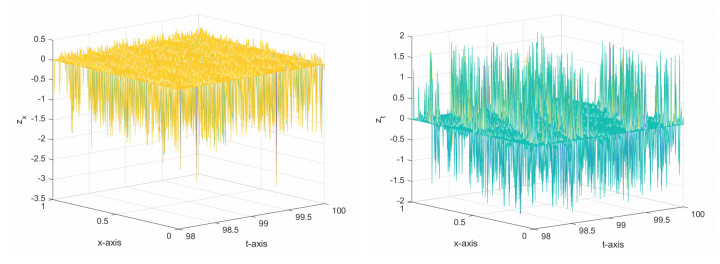









 DownLoad:
DownLoad:

